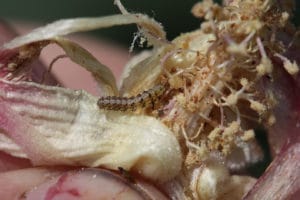Good news, bad news. The good news – I’ve only had a few calls about high infestation levels of bollworm (= corn earworm) in soybean. Most of these reports have been in late maturing soybean fields in or near the Mississippi River Bottoms. Bollworm infestation in cotton appear to be light to moderate. However, a number of people are seeing at least a few worms sneak past Bt cotton technologies. Also on the positive side, I’ve had feedback that applications of Prevathon or Besiege (mostly on the original WideStrike technology) appear to be working well, and I received similar feedback on applications of pyrethroid insecticides when mixed with acephate (mostly on Bollgard 2).

The bad news – Tennessee is surrounded by reliable reports that Bt cotton technologies are not providing satisfactory control of bollworms in some fields, and there are also reports of poor control with insecticide applications in cotton. A combination of high pressure, pyrethroid resistance, and bollworm resistance to Bt toxins is contributing to the problem.
It is very possible that late maturing cotton under moderate to high pressure will require an insecticide application to control bollworm. This is almost a given on WideStrike. It is critically important to closely scout susceptible cotton fields for bollworm infestations and make the appropriate insecticide application as needed. This does not mean spray every field. Our earliest cotton is already past the point of concern, having accumulated > 350 DD60s past NAWF5.
Below are a few thoughts for your consideration:
- Control of corn earworm (bollworm) in soybean as been very good with a number of products including Prevathon, Besiege, and Intrepid Edge. There are some other good options including Blackhawk or Steward. I would not use a pyrethroid insecticide (with or without acephate). If you have enough worms to spray, then use a product that provides reliable control. The most expensive insecticide application is the one that fails.
- I would make a similar suggestion in cotton with the caveat that a pyrethroid insecticide in combination with 0.75 lbs of acephate might be worth considering in Bollgard cotton if you are dealing with light pressure. I’m talking 4-6% small worms and a small number of eggs. However, control needs to be evaluated within 3-4 days of application.
- You can’t kill what isn’t there! There are too many people trying to convince me to recommend a pyrethroid insecticide application in late (R3) soybeans because they don’t want to come back and spray stink bugs or worms. To be blunt, this is a dumb idea. It’s your money, but pyrethroid insecticides will only provide residual control for 4-7 days (less if it rains). Stink bug populations have been very light, and when they do occur, they almost always start infesting fields closer to R5. There has been good research to show that insecticide applications made at R3 do not prevent stink bug infestations. Rather, they sometimes create late season problems with loopers. If you are really unlucky, you might spray a few days in front of a bollworm flight, and all you’ve done is take out beneficial insects.

